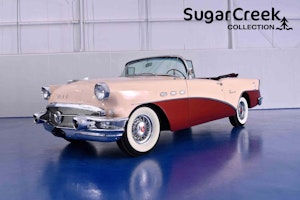Media | Articles
Are C5s collectible yet?
The fourth-generation Corvette lasted nearly a decade and a half, so the C5 was highly anticipated and a big breath of fresh air when it debuted for the 1997 model year. It was arguably the most radical ‘Vette in the history of America’s sports car.
The C5 was both lighter and stiffer than the C4, thanks in large part to its hydroformed frame rails, while the use of a transaxle improved weight distribution and cut down on the monstrous transmission tunnel that took up so much interior space in the C4. Perhaps most importantly, the C5 introduced the world to the LS engine, that endlessly tunable and swappable all-aluminum V-8. The LS made more power and was substantially lighter than the LT1 that it replaced, and while the interior of the C5 has been criticized for feeling a bit chintzy, it was a far cry from the squeaks and rattles that plagued the C4.
On track, the C5 snatched racing glory with numerous class wins at Le Mans, while on the road the high-performance Z06 version proved to be a world-class performer.
20171101141613)
Unlike its performance credentials, however, the C5’s late-1990s styling hasn’t aged nearly as gracefully. In addition, these are no longer new cars by any stretch—even the newest examples are rapidly approaching 15 years of age, while the earliest models have been around for two decades. It’s usually around this point where we start to ask when something is going to make that transition from used car to collectible automobile. While we still see C5s on the road commuting or burning through tires at track days, market patterns show that C5s are reaching the bottom of the depreciation curve and in some cases already have.
Marketplace
Buy and sell classics with confidence
Measuring buyer interest by Hagerty’s insurance quote activity, the C5 generation as a whole still appears to be depreciating, but the rate of depreciation is getting lower and lower. It looks like prices will bottom out some time next year. The average quoted value has fallen by 2 percent (or $400) over the past 12 months, although this number includes all C5 Corvettes. The base models make up the lion’s share of production and are, of course, the least valuable. Special models like the Z06, 50th Anniversary and Indy Pace Car, meanwhile, have actually seen value growth over the past couple of years and can already be considered collectible.
As for the run-of-the-mill, regular-production C5s, the majority were ordered with the four-speed automatic rather than the Borg Warner six-speed manual, so cars with the former can typically expect a 10-percent deduction in value. Convertibles are worth more than the hatchback coupe, but one C5 that is neither a limited edition nor a performance model with the best prospect for collectibility is the often-forgotten Fixed Roof Coupe. Built for the 1999 and 2000 model years, it made up only 6 percent and 12 percent of production for those years, respectively. Essentially a convertible model with a hardtop bolted and bonded in place, the new body style resulted in a 12-percent increase in structural rigidity over the standard hatchback. The Fixed Roof Coupe was manual-only and, thanks to its stiffer structure, provided the basis for the Z06 that would replace it in 2001.
20171101142321)
20171101142239)
20171101142259)
20171101142223)
Speaking of the Z06, among C5s these cars have seen the most significant value growth over the past couple of years, largely due to their status of being one of the top performers among enthusiast-oriented cars of the early 2000s. It delivered a knockout punch to its nemesis, the Dodge Viper, by being both quicker and cheaper, and was able to embarrass certain European exotics with even higher price tags. The Z06 has offered more performance per dollar than just about anything on the road for years now, and while it appears that the secret is starting to get out, it remainsa bargain supercar that presents a good buying opportunity. Arguably the most collectible of all C5s is the 2004 Z06 Commemorative Edition. A total of only 2,025 were built to celebrate the Corvette’s success at Le Mans, and, in addition to special blue paint with red and silver stripes, the Commemorative Edition had the usual high-performance Z06 equipment, plus a special carbon-fiber hood to reduce weight.
Other special models included the 50th Anniversary Edition, offered during 2003, and the Indy Pace Car version, offered in 1998. The 50th Anniversary was mostly an appearance package with special paint and badges, but Magnetic Selective Ride Control came standard. Anniversary cars have nevertheless seen a slight bump in value this year. The 1998 Indy Pace Cars, meanwhile, despite their almost retina-searing purple-over-yellow color scheme, have logged considerable value gains since 2015 given that a little over 1,100 were built, and because the limited-edition pace car version of any car becomes collectible eventually.
On the whole, C5s are doing better, price-wise, than the somewhat unloved C4s, but base-model fifth-gen Corvettes can still be considered used cars that continue to depreciate, at least in the near term. Limited-edition or Z06 models, on the other hand, are getting attention, showing up at auction and generally commanding higher prices than they were a year ago.
20171101141759)
20171101141957)









